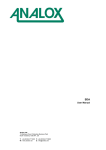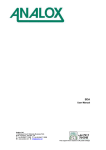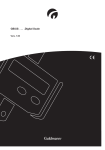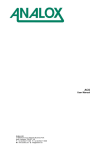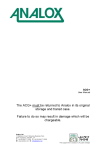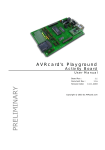Download OEM User Manual - Analox sensor technology
Transcript
MEC OEM User Manual Analox 15 Ellerbeck Court, Stokesley Business Park North Yorkshire, TS9 5PT, UK T: +44 (0)1642 711400 F: +44 (0)1642 713900 W: www.analox.net E: [email protected] This support line is closed on UK public holidays MEC OEM User Manual List of Contents 1 2 Safety information ...............................................................................................................6 About the MEC ...................................................................................................................7 2.1 MEC variants available ...............................................................................................7 3 Installation ...........................................................................................................................8 3.1 Physical mounting .......................................................................................................8 3.2 Gas connections .........................................................................................................9 3.3 Electrical connections (External) ............................................................................. 10 3.4 Electrical connections (Internal) .............................................................................. 10 3.5 Power/Comms connections ..................................................................................... 10 3.6 4-20mA Quick Start Guide ....................................................................................... 11 3.7 Sensor connections ................................................................................................. 12 3.8 RS485 communication............................................................................................. 13 3.9 Operation ................................................................................................................. 13 4 Sensor replacement......................................................................................................... 14 4.1 Oxygen sensor replacement .................................................................................... 14 4.2 Toxic gas sensors .................................................................................................... 15 4.3 Helium sensor replacement ..................................................................................... 17 Calibration ................................................................................................................................ 18 4.4 Performing a calibration ........................................................................................... 18 5 Spares and Accessories .................................................................................................. 21 6 Specifications ................................................................................................................... 22 6.1 MEC-O2 ................................................................................................................... 22 6.2 MEC-CO (20ppm range).......................................................................................... 22 6.3 MEC-CO (500ppm range)........................................................................................ 22 6.4 MEC-H2S ................................................................................................................. 23 6.5 MEC-NO2 ................................................................................................................ 23 6.6 MEC-NO .................................................................................................................. 23 6.7 MEC-SO2 ................................................................................................................ 24 6.8 MEC-He ................................................................................................................... 24 6.9 MEC 4-20mA ........................................................................................................... 24 7 General care and disposal ............................................................................................... 25 Document Ref: MEC-802-07 - May 2014 Page 4 MEC OEM User Manual Document Ref: MEC-802-07 - May 2014 Page 5 MEC OEM User Manual 1 Safety information WARNING: Read the safety information fully before using the Analox MEC. Electrochemical sensors The sensor used in particular variants of MEC is an electrochemical sensor which contains toxic compounds. Under normal conditions the sensor will be safely sealed. To prevent leakage, the unit must not be exposed to temperatures outside the specified range, or be exposed to organic vapours, which may cause physical damage to the body of the sensor. The unit must not be stored in areas containing organic solvents or in flammable liquid stores. When the life of the sensor has expired or it is leaking or otherwise damaged it must be disposed of safely in accordance with local regulations. Electrochemical sensors contain caustic electrolyte (acidic or alkali depending on type) which is hazardous. In the event of an accident, use the following first aid procedures Body Part Skin Effect Contact could result in a chemical burn. Persons with pre-existing skin disorders may be more susceptible to the effects of the substance. Ingestion Eye Corrosive. May cause sore throat, abdominal pain, nausea, and severe burns of the mouth, throat, and stomach, and may be fatal. Persons with pre-existing eye problems may be more susceptible to the effects of the substance. First Aid Procedures Immediately flush the skin thoroughly with water for at least 15 minutes. Remove contaminated clothing and wash before re-use. Obtain medical advice if continued irritation. If swallowed DO NOT INDUCE VOMITING. Wash out mouth thoroughly with water and give plenty of water to drink. Obtain medical advice immediately Irrigate thoroughly with water for at least 15 minutes. Obtain medical advice immediately. Corrosive. May cause redness, pain, blurred vision, and eye burns. Inhalation Contact can result in the permanent loss of sight. Persons with pre-existing impaired respiratory function may be more susceptible to the effects of the substance. Remove to fresh air. Rest and keep warm. Obtain medical advice if applicable. Inhalation is not an expected hazard unless heated to high temperatures. Mist or vapour inhalation can cause irritation to the nose, throat, and upper respiratory tract. Document Ref: MEC-802-07 - May 2014 Page 6 MEC OEM User Manual 2 About the MEC The Analox MEC is a small, robust sensor module available in a range of gas variants. All variants are housed in an IP65 enclosure and conform to the same physical dimensions, power requirements and communication protocol. An integral pressure sensor provides compensation for the effects of atmospheric pressure where appropriate. Digital communication via RS485 permits mounting the sensor remotely from the monitoring equipment The Analox MEC allows for easy replacement of sensor cells. 2.1 MEC variants available The Analox MEC is available in the variants shown in Table 1below: Gas *Oxygen *Oxygen *Carbon monoxide *Carbon monoxide *Hydrogen sulphide Helium Helium1 *Nitrogen dioxide *Nitric oxide *Sulphur dioxide 4-20mA Range Part Number 0-3000mBar MECO2ABBP 0-100% MECO2DBBP 0-20ppm MECCOEBAP** 0-500ppm MECCORBAP 0-50ppm MECUJBAP 0-100% MECHEMBAP 0-100% (mbar output) MECHEMBDP 0-10ppm MECPGBAP 0-100ppm MECQKBAP 0-20ppm MECTHBAP 0-60000mbar MECVTBBP Table 1 Node Address $40 $40 $50 $50 $30 $80 $80 $52 $51 $53 $F8 * A hydrator should be installed if the MEC is going to be continuously connected to a dry gas source with no exposure to ambient air. The hydrator is required to pull moisture from the ambient air to re-hydrate the electrochemical cells within the MEC. If dry gas is constantly being passed over the sensors their life will be dramatically shortened. The hydrator is available from Analox Ltd, part number is listed in section 5. ** When ordering a spare carbon monoxide MEC (Part Number MECCOEBAP) it will leave the factory after being tested with a nitrogen balance span gas. The MEC CO should have a span done prior to use with a balance gas to match the gas being analysed (Either a nitrogen or helium balance). 1 NOTE: Helium MEC (MECHEMBDP) requires a remote pressure source to work correctly. Document Ref: MEC-802-07 - May 2014 Page 7 MEC OEM User Manual 3 Installation 3.1 Physical mounting The sensor is housed in an IP65 ABS box with integrated mounting holes. The instrument should be screwed to a suitable surface using the two mounting holes indicated in the drill drawing in Figure 1 (all dimensions in mm). Figure 1 The enclosure lid holes are located in the top left and bottom right of the enclosure. These are captive screws. The mounting holes of the enclosure are located at the top right and bottom left of the enclosure. A 4mm hole is pre-drilled at these corners that will accept an M4 screw thread. For the initial installation the enclosure lid should be removed to access the mounting hole chambers. The mounting screws are fitted in to these and the enclosure can then be secured to a suitable surface using either tapped holes or nuts. The maximum allowable diameter of the screw head that can be fitted in to the mounting hole chambers is 6.5mm. Document Ref: MEC-802-07 - May 2014 Page 8 MEC OEM User Manual Mounting hole chambers In the lid at the mounting hole corners there are 4mm access holes predrilled to allow the mounting screws to be accessed. Once mounted, this enables the MEC to be removed from its mounting position without needing to remove the enclosure lid. The mounting screws will then remain captive as long as the lid remains fitted. Mounting screw access holes 3.2 Gas connections The sensor may either monitor gas in the surrounding atmosphere or a flow adapter can be inserted into the gas port inlet to allow monitoring of pumped sample gas from a remote location. When used to monitor a pumped sample, Analox recommend that a short length (10-30cm) of tubing should be attached to the flow adapter exhaust. Care should be taken to ensure that the sample flow rate is within specification and that the exhaust line is not restricted, otherwise gas pressure within the sensor may be increased, resulting in false, elevated measurement readings or damage to the sensor. Monitoring local atmosphere Monitoring a remote atmosphere via a sample line Note: If the application in which the MEC is being used is monitoring via a sample line the humidity of the gas must be taken in to consideration as long term exposure of electrochemical cells to low humidity gas (<15%RH) will result in a degrading of the sensor performance. Also, the material that the pipe-work is made from must also be considered. Document Ref: MEC-802-07 - May 2014 Page 9 MEC OEM User Manual Certain gasses can exhibit a property by which they ‘stick’ to inside of the pipe which results in inaccurate measurement of the target gas. In such cases it is advised to use pipe-work that prevents the gas from ‘sticking’ such as PTFE. Please consult Analox for guidance. 3.3 Electrical connections (External) Electrical connections with the sensor are made via a short screened cable. The cable screen is made off into a green/yellow wire terminated with an M4 ring terminal. This wire is unterminated inside the MEC enclosure. CORE COLOUR Red Blue Yellow Green Green/Yellow SIGNAL +SUPPLY -SUPPLY RS485A RS485B Earth Table 2 DETAILS Power Supply 5V DC RS485 communications Screen 5 4 3 2 1 Use of the screen will depend on the particular installation. It is best connected to a clean Earth to form a shield around the sensor cable. Note that it is not recommended for the screen to be connected to the negative supply line. 3.4 Electrical connections (Internal) The electrical connections made to the internal electronics are made via clamp terminals. It is important to ensure that each core of the cable is connected to the correct terminal. Each MEC has a Power/Comms terminal block and a sensor terminal block. 3.5 Power/Comms connections Table 3 details the internal wiring termination for the MEC connection cable. This is standard for all variants of MEC. CORE COLOUR SIGNAL TERMINAL Red +SUPPLY J2.1 Blue -SUPPLY J2.2 Yellow RS485A J2.3 Green RS485B J2.4 Table 3 Document Ref: MEC-802-07 - May 2014 Page 10 MEC OEM User Manual 3.6 4-20mA Quick Start Guide Document Ref: MEC-802-07 - May 2014 Page 11 MEC OEM User Manual 3.7 Sensor connections Table 4 details the internal wiring termination for the MEC sensors. Each MEC variant has a sensor termination that is particular to the type of sensor that is used in that variant. MEC VARIANT WIRE COLOUR TERMINAL Oxygen Red J3.1 Black J3.2 Carbon monoxide Red J3.1 Black J3.2 Yellow J3.3 Hydrogen sulphide See Carbon monoxide Nitrogen dioxide Nitric oxide Sulphur dioxide Helium Black J3.1 Red J3.2 Blue J3.4 4-20mA Red J3.1 Black J3.2 Table 4 J2.1 J2.2 J2.3 J2.4 J3.1 J3.2 J3.3 J4.4 The example shown below is of an MEC-Oxygen, showing the Power/comms and sensor connections Document Ref: MEC-802-07 - May 2014 Page 12 MEC OEM User Manual 3.8 RS485 communication Using RS485 communication data from the sensor can be obtained, and calibration commands may be sent to the sensor. The hardware protocol is 9600 baud, 1 start bit, 2 stop bits, 8 data bits. Please see P0075-805-01 ACG OEM Communication Manual for a description of the serial communication protocol, with code and message examples. 3.9 Operation After switch on, the sensor takes about thirty seconds to warm up. The MEC will then continuously monitor the gas levels. During operation the unit continuously runs various self-checks and sets fault flags accordingly. The status of these flags is available via the command G flags. Please see P0075-805-01 ACG OEM Communication Manual for details of sensor fault flags. Document Ref: MEC-802-07 - May 2014 Page 13 MEC OEM User Manual 4 Sensor replacement The sensor replacement procedure is specific to the sensor type that is used for that particular variant of MEC. The following sections detail the procedure for replacement of the different sensor types used. 4.1 Oxygen sensor replacement Replacement part number for your sensor is: 9100-9212-9HM 4.1.1 Ensure all electrical connection between the MEC and monitor equipment are disconnected. 4.1.2 Loosen the corner screws of the enclosure and remove the lid. 4.1.3 Using a terminal screwdriver push down the clamp release button to release the clamp and gently pull the cell wire from the clamp. Repeat this for both the red and black wires. Document Ref: MEC-802-07 - May 2014 Page 14 MEC OEM User Manual 4.1.4 Unscrew the green lock ring from the chimney of the cell housing and remove from the enclosure lid. 4.1.5 Fit the new cell in to the enclosure lid and secure in place using the lock ring. 4.1.6 Using a terminal screwdriver, push down the clamp release button to release the clamp. Push the ferrule of the cell wire in to the clamp and remove the screwdriver from the clamp release button. Gently pull on the wire to ensure that the wire is held by the clamp. Repeat this for both the red and black wires, taking note of the correct polarity as shown below. Red (+ve) Black (-ve) 4.1.7 Refit the enclosure lid in place and secure in place using the corner screws. 4.1.8 Following a sensor replacement a full calibration MUST be performed 4.2 Toxic gas sensors Toxic gas sensor type covers a range of sensors of particular target gas. These are shown in Table 5 with the corresponding part number for the replacement sensor. NOTE: Toxic gas sensors are not designed to be continuously exposed to their target gas, they are best to be used to detect elevated levels of target gas. Document Ref: MEC-802-07 - May 2014 Page 15 MEC OEM User Manual Gas Carbon monoxide Hydrogen sulphide Nitrogen dioxide Nitric oxide Sulphur dioxide Replacement cell part number 9100-2030 9100-2041 9100-2044 9100-2045 9100-2042 Table 5 NOTE: A Nitric oxide (NO) MEC sensor needs a minimum of 8 hours from power up to settle before a valid reading can be taken. 4.2.1 Ensure all electrical connection between the MEC and monitor equipment are disconnected. 4.2.2 Use a flat blade screwdriver to pop out the cell holder from the sensor bulkhead fitting. 4.2.3 Rotate the cell PCB connector clockwise to release from the cell holder. 4.2.4 Disconnect the cell from the PCB connector. Document Ref: MEC-802-07 - May 2014 Page 16 MEC OEM User Manual 4.2.5 Connect the new cell to the PCB connector (Note that it will only connect in one orientation). 4.2.6 Fit the cell in to the housing in the reverse action of step 4.2.3 4.2.7 Refit the cell holder in to the sensor bulkhead. 4.2.8 Following a sensor replacement a full calibration MUST be performed. 4.3 Helium sensor replacement Replacement part number for your sensor is: 9100-4535/MEC 4.3.1 Ensure all electrical connection between the MEC and monitor equipment are disconnected. 4.3.2 Loosen the corner screws of the enclosure and remove the lid. 4.3.3 In the same way as shown in section 4.12 for the Toxic sensor, using a terminal screwdriver push down the clamp release button to release the clamp and gently pull the cell wire from the clamp. Repeat this for the red, black and blue wires. Document Ref: MEC-802-07 - May 2014 Page 17 MEC OEM User Manual Calibration Whilst in use, an MEC sensor should be periodically calibrated at intervals deemed necessary for the monitoring application by exposing the sensor to gas of a known concentration. Calibration adjustments of the sensor’s output can be made where necessary as follows. Each sensor’s output is defined by two calibration points, one low and one high. To perform a successful calibration adjustment, both low and high calibration points should be adjusted. Note: The high and low calibrations performed on a sensor should be selected appropriately. An MEC does not require that the low calibration is a true zero calibration (ie. zero concentration of the target gas), but for greatest accuracy across the whole sensor range it is recommended that a gas with a known zero concentration of the target gas is used. No additional calibration should be required for the 4-20mA MEC. See section 5 for list the recommended calibration gasses for all MEC variants. 4.4 Performing a calibration The following equipment is required to perform a calibration on an MEC: Bottles of High and Low calibration gas, flow regulator, flow adaptor and tubing. Document Ref: MEC-802-07 - May 2014 Page 18 MEC OEM User Manual 4.4.1 Push one end of the tubing onto one of the barbs of the flow adaptor and the other onto the outlet of the flow regulator. 4.4.2 Screw the flow regulator into the valve of the low calibration gas bottle. 4.4.3 Insert the flow adaptor into the gas port of the MEC sensor. 4.4.4 Open the flow regulator valve to deliver a flow of between 0.2 and 1.0 litres per minute. Document Ref: MEC-802-07 - May 2014 Page 19 MEC OEM User Manual 4.4.5 Allow the calibration gas to flow for a few minutes or until the reading has stabilised. 4.4.6 Perform the calibration by sending the MEC sensor the appropriate calibration command. Please see P0075-805-01 ACG OEM Communication Manual for details of the calibration command using the serial communication protocol. 4.4.7 Close the flow regulator valve once complete. 4.4.8 Repeat steps 4.4.2 to 4.4.7 with the high calibration gas. 4.4.9 Once complete remove the flow adaptor from the gas port. Document Ref: MEC-802-07 - May 2014 Page 20 MEC OEM User Manual 5 Spares and Accessories Item 1 2 3 4 Description Calibration flow adaptor 0.5LPM 110L bottle regulator Hydrator Bulgin 3 way plug connector Part no. 8000-0910A SA7L705XFLIND P0075-455K PXP6010/03S/ST/0507 Table 6 - Accessories Item 1 2 3 4 5 6 7 Description MEC O2 cell (electrochemical) MEC CO cell (electrochemical) MEC H2S cell (electrochemical) Item MEC-O2 1 2 Description MEC-CO 1 2 MEC-H2S 1 2 MEC-He 1 2 Part no. 9100-9212-9HM 9100-2030 9100-2041 Nitrogen dioxide 9100-2044 Nitric oxide 9100-2045 Sulphur dioxide 9100-2042 MEC He cell (pellistors) 9100-4535/MEC Table 7 – Replacement cells Zero calibration gas (N2) Span calibration gas balance N2) Part no. (20.9% O2 SA7L10501 SA7L110179 Zero calibration gas (20.9% O2 balance N2) Span calibration gas (18ppm CO, 20.9% O2 balance N2) SA7L110179 Zero calibration gas (20.9% O2 balance N2) Span calibration gas (50ppm H2S, 20.9% O2 balance N2) SA7L110179 Zero calibration gas (N2) Span calibration gas (100% He) SA7L10501 SA7L110120 SA7L110176 SA7L110820 Table 8 – Recommended calibration gas Document Ref: MEC-802-07 - May 2014 Page 21 MEC OEM User Manual 6 6.1 Specifications MEC-O2 Range Temperature range Accuracy (over ±10°C range) Detection mode Sensor life Supply voltage Data output Enclosure dimensions (H x W x D) 6.2 Temperature coefficient = 0.15% of reading/°C or 0.084% of reading/°F Electrochemical 2 years for the electrochemical cell in atmospheric air Supply voltage 5.0V dc (±0.5V) RS485 using Analox protocol 65 x 50 x 35 mm MEC-CO (20ppm range) Range Temperature range 0-20ppm Accuracy (over ±10°C range) Detection mode Sensor life Supply voltage Data output Enclosure dimensions (H x W x D) 6.3 0 to 100% (Atmospheric pressure) 0 to 3000mBar (Hyperbaric) -5°C to 55°C (23°F to 131°F ) ±(0.035% O2 + 1% of reading + Temp coefficient) 0 to 20ppm -5°C to 55°C (23°F to 131°F ) ±(1ppm CO + 5% of reading + Temp coefficient) Temperature coefficient = 0.1ppm CO/°C + 0.5% of reading/°C or 0.056ppm CO/°F + 0.278% of reading/°F Electrochemical 2 Years in operation Supply voltage 5.0V dc (±0.5V) RS485 using Analox protocol 65 x 50 x 35 mm MEC-CO (500ppm range) Range Temperature range 0-500ppm Accuracy (over ±10°C range) Detection mode Sensor life Supply voltage Data output Enclosure dimensions (H x W x D) Document Ref: MEC-802-07 - May 2014 Page 22 0 to 500ppm -20°C to 40°C (-4°F to 104°F ) ±(2ppm CO + 5% of reading + Temp coefficient) Temperature coefficient = 0.4% of reading /°C or 0.222% of reading /°F Electrochemical 2 Years in operation Supply voltage 5.0V dc (±0.5V) RS485 using Analox protocol 65 x 50 x 35 mm MEC OEM User Manual 6.4 MEC-H2S Range Temperature range Accuracy 0 to 50ppm -5°C to 55°C (23°F to 131°F ) ± (2ppm + Temp coefficient) Detection mode Sensor life Supply voltage Data output Enclosure dimensions (H x W x D) Temperature coefficient = 0.075 ppm/°C or 0.042 ppm/°F Electrochemical 2 Years in operation Supply voltage 5.0V dc (±0.1V) RS485 using Analox protocol 65 x 50 x 35 mm 6.5 MEC-NO2 Range Temperature range Accuracy 0 to 10ppm -5°C to 55°C (23°F to 131°F ) ± (1ppm + Temp coefficient) Detection mode Sensor life Supply voltage Data output Enclosure dimensions (H x W x D) Temperature coefficient = 0.05 ppm/°C or 0.028 ppm/°F Electrochemical 2 Years in operation Supply voltage 5.0V dc (±0.5V) RS485 using Analox protocol 65 x 50 x 35 mm 6.6 MEC-NO Range Temperature range Accuracy 0 to 100ppm -5°C to 45°C (23°F to 113°F ) ± (4ppm + Temp coefficient) Temperature coefficient = 0.17 ppm/°C or 0.094 ppm/°F Detection mode Electrochemical Sensor life 2 Years in operation Supply voltage Supply voltage 5.0V dc (±0.5V) Data output RS485 using Analox protocol Enclosure dimensions (H x W x D) 65 x 50 x 35 mm NOTE: A Nitric oxide (NO) MEC sensor needs a minimum of 8 hours from power up to settle before a valid reading can be taken. Document Ref: MEC-802-07 - May 2014 Page 23 MEC OEM User Manual 6.7 MEC-SO2 Range Temperature range Accuracy 0 to 20ppm -5°C to 55°C (23°F to 131°F ) ± (2ppm + Temp coefficient) Detection mode Sensor life Supply voltage Data output Enclosure dimensions (H x W x D) Temperature coefficient = 0.1 ppm/°C or 0.056 ppm/°F Electrochemical 2 Years in operation Supply voltage 5.0V dc (±0.5V) RS485 using Analox protocol 65 x 50 x 35 mm 6.8 MEC-He Range Temperature range Accuracy 0 to 100% -5°C to 55°C (23°F to 131°F ) ± (2%FS + Temp coefficient) Detection mode Sensor life Supply voltage Data output Enclosure dimensions (H x W x D) Temperature coefficient = 0.05 %FS/°C or 0.028 %FS/°F Pellistor Up to 5 Years Supply voltage 5.0V dc (±0.1V) RS485 using Analox protocol 65 x 50 x 35 mm 6.9 MEC 4-20mA Range Temperature range Accuracy 0 to 60000mBar -5°C to 55°C (23°F to 131°F ) ± 0.15% FS Detection mode Supply voltage Data output Enclosure dimensions (H x W x D) 4-20mA Supply voltage 5.0V dc (±0.5V) RS485 using Analox protocol 65 x 50 x 35 mm Document Ref: MEC-802-07 - May 2014 Page 24 MEC OEM User Manual 7 General care and disposal Although designed to be water resistant the MEC should not be intentionally immersed in liquid or left outside unprotected. To clean the MEC use a damp soft cloth. According to WEEE regulation this electronic product can not be placed in household waste bins. Please check local regulations for information on the disposal of electronic products in your area. Document Ref: MEC-802-07 - May 2014 Page 25

























